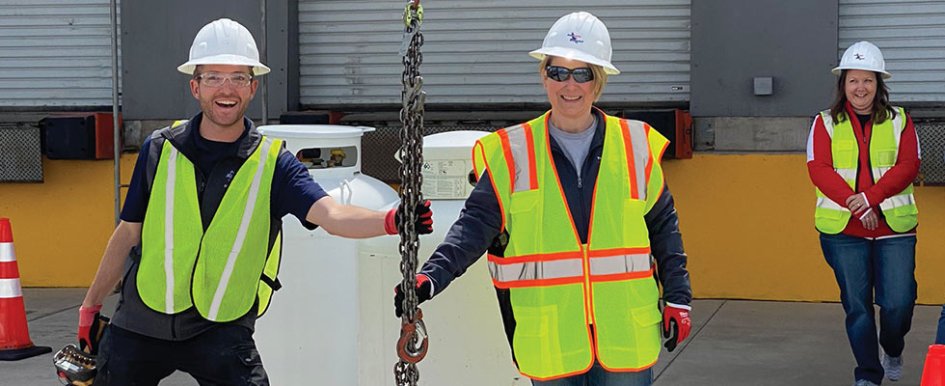
Employees’ desire for a more robust work experience continues to increase post-pandemic. As employees are looking to future-proof their careers, they’re seeking opportunities to build deeper connections with others, be part of the bigger vision and maintain autonomy while mastering new skills and developing their passions.
As companies strive to remain competitive, investing in continuous learning and giving employees a chance to grow through stretch assignments has emerged as a game-changing strategy. Coaching and encouraging employees through projects that expand their knowledge and experience enables us to foster professional growth and drive the long-term success of our employees and organizations. By creating opportunities for employees to participate in upskilling and stretch projects, we can ensure employees are fulfilled in their careers.
In a recent survey conducted by Gallup, 65% of workers in the U.S. believe employer-provided upskilling is very important when evaluating a potential new job, while 57% want to update their skills in their current role. Additionally, a study conducted by Harvard Business Review found that 71% of executives interviewed named participation in stretch projects as the biggest impact on unleashing their potential. It is clear employees desire development, but what exactly are upskilling and stretch projects, and what impact do they have on organizations?
Developing Employee Skills
Upskilling refers to the strengthening of existing skills and learning complementary skills, while stretch assignments aim to take an individual out of their comfort zone and develop skills or knowledge beyond their current role. Both may sound reasonable, but often organizations are not able to offer either due to constraints like strategies focused on the short-term coupled with a lack of time, awareness or budget. Many organizations focus on investing their primary resources in new employees and maintaining certifications required by the industry. Meanwhile, we often overlook identifying our existing employees’ passions and creating opportunities for their development through upskilling and stretch projects.
You may wonder why these strategies are important. Humans are designed to be lifelong learners; we are led by curiosity. Think of a child exploring new shapes, textures, nature and food. Fast-forward in life and you will see the emphasis on innovation and AI in business, both of which are driven by curiosity and the hunt for new ways to increase efficiency. Learning is innate to us; we don’t check it at the doors of our workplaces. Instead, providing opportunities for our employees to continue to learn new skills and expand their experiences demonstrates how much we value them and that they are a vital part of the organization’s future.
Learning also fuels connectedness among teams and drives employee engagement. Studies show that engagement and learning go hand in hand to develop stronger teams, increase job satisfaction and develop the future leaders of our organizations.
Creating an environment and programs to support upskilling and stretch projects can seem daunting. You might wonder, “Where do we begin?” or, “What are the most important skills to develop?” or, “How can we possibly create stretch projects for each individual person within the organization?” These are all great questions, but let’s take a step back and start at the beginning.
Building a Healthy Growth Plan
How do leaders and organizations become aware of the areas that interest employees? This is a great starting point, and it’s a simple answer: ask. To understand what is important to employees, take time to meet with them one on one. Ask what gaps in knowledge or experience they feel they have, where they would like to learn more, what their long-term career goals and passions are, and where they feel they can make more of an impact.
For larger groups of people, surveys can be efficient and effective. When using surveys, focus on identifying gaps and areas that will help groups of people. Using surveys will be less effective in gaining insight into individual passions and stretch projects but can provide you with trends.
Regardless of the methods you choose, the power is in the ask. Organizations sometimes fall into the trap of making assumptions about what employees need, and then provide training and learning opportunities to fit those assumptions. Often these training initiatives miss the mark and don’t meet the needs of the employees or accomplish the vision intended for the organization. Being intentional about conversations will pay dividends in both the short and long term for all involved.
Once the topics that resonate with employees have been identified, you can build an upskilling growth plan for employees that enables them to invest in themselves and increase their involvement in the organization. Use varied methods of training in the plan, including in-person and virtual instructor-led training; learning management system courses; mentoring sessions; self-driven learning; stretch projects; and additional certifications through accredited continuing education programs. Growth plans are a great way to organize, track and demonstrate employees’ progress toward their career goals. Provide employees with incremental goals within the growth plan, which will allow for them to celebrate successes along the way while envisioning a road to their future.
Stretch projects can be an integral part of a growth plan, or they can stand alone. Encourage employees to position themselves for a stretch project by building their network with decision-makers, as well as sharing their passion for areas outside of their primary responsibility. As a leader, identify high-potential employees within your workforce and pull them into ongoing projects to maximize their strengths and impact on the company.
For leaders and employees both, starting the conversation is the first step in recognizing the true potential of upskilling and stretch projects. From retaining top talent and building a skilled and engaged workforce, to increasing productivity through maximizing the use of tools and knowledge every day, compelling evidence speaks to the value of stretch projects. In today’s dynamic business landscape, investing in upskilling and stretch projects is no longer a luxury, but rather is a strategic necessity for organizations and employees alike.



